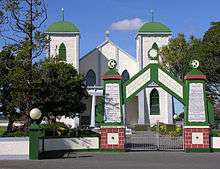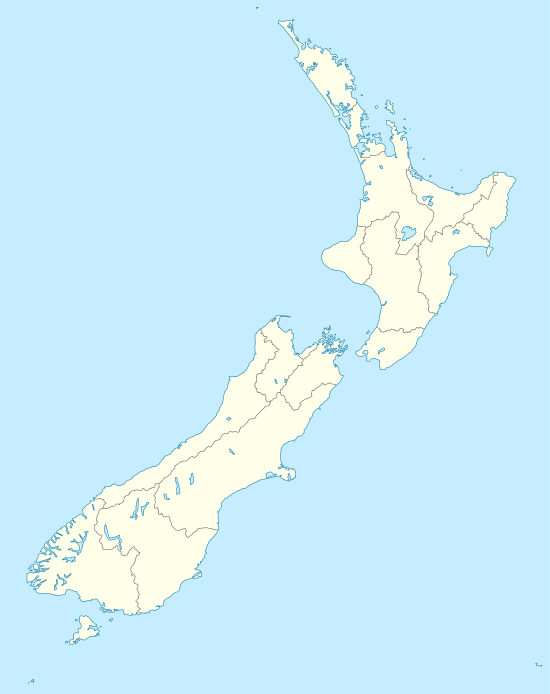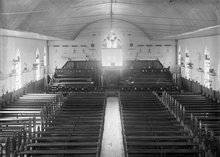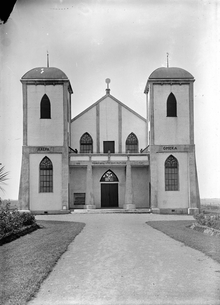Rātana Pā
Rātana Pā, or Ratana Community,[lower-alpha 1] is a town in the North Island of New Zealand, near Whanganui and Marton in the Manawatū-Whanganui region. The locality was the farm of Tahupōtiki Wiremu Rātana, the founder of a Maori religious and political movement, and the settlement developed in the 1920s as followers came to see Rātana. It continues as the centre of the Rātana Church.[2] Due to the importance of the Rātana movement in New Zealand politics, leading New Zealand politicians often attend annual gatherings at Rātana Pā.
Ratana Community Rātana Pā | |
|---|---|
Town | |
 The temple at Rātana Pā | |
 Ratana Community | |
| Coordinates: 40°02′24″S 175°10′40″E | |
| Country | New Zealand |
| Region | Manawatū-Whanganui |
| Territorial authority | Rangitikei District |
| Government | |
| • Mayor | Andy Watson |
| • MP | Ian McKelvie |
| Population | |
| • Total | 327 |
Location
Rātana Pā is 20 km south-east of Whanganui, 5 km west of Turakina and 19 km west of Marton. It lies between State Highway 3 and the coast.
History

Rātana Pā is on what was the farm of Tahupōtiki Wiremu Rātana, the founder of the Rātana religious and political movement and the Rātana Church. The locality became a settlement of Rātana followers in the 1920s.
Facilities at Rātana Pā include the 1,000-seat Temepara Tapu o Ihoa (Holy Temple of Jehovah),[2] the Manuao (an accommodation facility and head office of the church), the Whare Māori (which contains crutches and wheelchairs from followers who were healed by Rātana in the 1920s and 1930s) and the Ratana Archives Center, which contains artifacts and stories from the history of the Rātana Church.
25 January and 8 November are anniversary days of the Rātana Church. On these days thousands of members of the church converge on Rātana Pā for the special anniversary services commemorating the birth of Rātana (25 January 1873) and his first spiritual vision (8 November 1918). The gathering for the birth anniversary lasts for a week, with the highlight being the Temple Service on 25 January. Usually, Members of Parliament (MPs) visit on 24 January to talk and seek the votes of Māori.
Government and politics
Local government
Rātana Pā is in the Southern ward of Rangitikei District, which elects three of the eleven members of the Rangitikei District Council. There is also a Rātana Community Board, one of two community boards in the District (the other being for Taihape).[3] The Board has four elected members and one appointed councillor from the Southern ward.[4]
National government
Rātana Pā, like the rest of the Rangitikei District, is located in the general electorate of Rangitīkei and in the Māori electorate of Te Tai Hauāuru.[5] Rangitīkei is a safe National Party seat since the 1938 election with the exception of 1978–1984 when it was held by Bruce Beetham of the Social Credit Party. Since 2011 it is held by Ian McKelvie.[6]
Te Tai Hauāuru is a more volatile seat, having been held by three different parties since 1996, i.e. New Zealand First, the Māori Party and the Labour Party.[7] Since 2014 it is held by Adrian Rurawhe of the Labour Party.[8]
Demographics
| Year | Pop. | ±% p.a. |
|---|---|---|
| 2001 | 423 | — |
| 2006 | 366 | −2.85% |
| 2013 | 327 | −1.60% |
| Source: [1] | ||
Ratana Community[lower-alpha 1] had a population of 327 according to the 2013 New Zealand census. This is a decrease of 39, or 10.7 percent, since the 2006 census. There were 102 occupied dwellings, 15 unoccupied dwellings, and no dwellings under construction.[1]

Of the residential population, 138 (42.2%) were male compared to 48.7% nationally, and 192 (57.8%) were female, compared to 51.3% nationally. The district had a median age of 34.5 years, 3.5 years below the national median age of 38.0 years. People aged 65 and over made up 15.6% of the population, compared to 14.3% nationally, and people under 15 years made up 22.9%, compared to 20.4% nationally.[1]
The community's ethnicity is made up of (national figures in brackets): 96.9% Māori (14.9%), 9.4% European (74.0%), 3.1% Pacific Islanders (7.4%), 0.0% Asian (11.8%), 0.0% Middle Eastern, Latin American or African (1.2%), and 0.0% Other (1.7%).[1]
Ratana Community had an unemployment rate of 17.8% of people 15 years and over, compared to 7.4% nationally. The median annual income of all people 15 years and over was $19,000, compared to $28,500 nationally. Of those, 50.0% earned under $20,000, compared to 38.2% nationally, while 14.1% earned over $50,000, compared to 26.7% nationally.[1]
Transport
State Highway 3 ![]()
InterCity runs three daily and six non-daily services at the Ratana Turn Off stop. These include Palmerston North–Auckland, Wellington–New Plymouth and Auckland–Palmerston North.[9]
The nearest airport is Whanganui Airport, located 22 km to the northwest of the town.
Education
Te Kura o Ratana is a state-integrated co-educational Rātana Church primary school for Year 1 to 8 students,[10] with a roll of 24 as of March 2020.[11]
The nearest secondary schools are in Whanganui and Marton.
Table footnotes
- As defined by Statistics New Zealand.[1]
References
- "2013 Census QuickStats about a place: Ratana Community". Statistics New Zealand. Retrieved 2 February 2016.
- Newman, Keith. "The Founding of a Faith". New Zealand Historic Places Trust. Archived from the original on 2011-06-12. Retrieved 2019-08-03.
- "Community Boards". Rangitīkei District Council. Retrieved 12 January 2020.
- "Change to Rangitīkei District Council ward structure from 5 to 3". Rangitīkei District Council. 26 April 2019. Retrieved 12 January 2020.
- "Find my Electorate". Electoral Commission. Retrieved 1 February 2016.
- "Rangitīkei Electorate Profile". New Zealand Parliament. 30 September 2012. Retrieved 1 February 2016.
- "Te Tai Hauāuru Electorate Profile". New Zealand Parliament. 30 September 2012. Retrieved 1 February 2016.
- "Rurawhe, Adrian". New Zealand Parliament. 4 December 2015. Retrieved 1 February 2016.
- "Ratana Turn Off – Bus Timetable". InterCity. 1 February 2016. Retrieved 2 February 2016.
- "Ministry of Education School Profile". educationcounts.govt.nz. Ministry of Education.
- "Education Review Office Report". ero.govt.nz. Education Review Office.